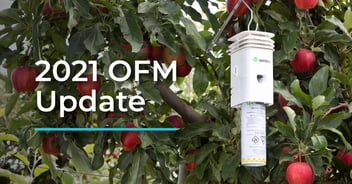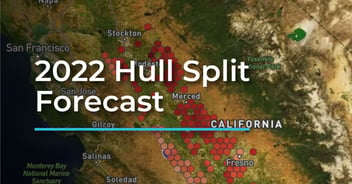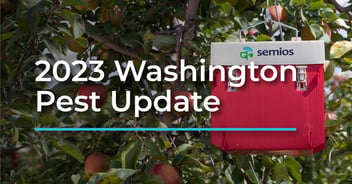2024 California Hull Split Forecast & Navel Orangeworm Update
Our regional 1% hull split predictions and mid-season navel orangeworm update are now available!
Each site is pre-set with regional full bloom (100% bloom) dates provided by Blue Diamond. If you've observed full bloom dates for your varieties, we encourage you to input this information into Semios Live to help tailor your hull split predictions to your orchards.
In the image below, the earliest predicted Nonpareil 1% split is July 2nd, and the latest is July 14th. Refer to the gradient legend to the right of the map to see how your region compares.
2024 1% Nonpareil Predicted Hull Split for the Central Valley
 A map of California Central Valley showing the predicted nonpareil 1% hull split dates for the 2024 season. Areas with the earliest predicted 1% split dates (early July) are shown in the lightest blue color. Areas with the latest predicted 1% split dates (mid-July) are shown in the darkest blue color.
A map of California Central Valley showing the predicted nonpareil 1% hull split dates for the 2024 season. Areas with the earliest predicted 1% split dates (early July) are shown in the lightest blue color. Areas with the latest predicted 1% split dates (mid-July) are shown in the darkest blue color.
The next image below shows a summary of navel orangeworm (NOW) movements across the Central Valley at an aggregated view.
Summary of Navel Orangeworm (NOW) Movements Across the Central Valley
 Proportion of traps that caught NOW across the Central Valley, averaged together. In the bar chart to the left, the blue bars represent the number of live camera traps. The green bars indicate the number of live camera traps that recorded a NOW trap capture on that day.
Proportion of traps that caught NOW across the Central Valley, averaged together. In the bar chart to the left, the blue bars represent the number of live camera traps. The green bars indicate the number of live camera traps that recorded a NOW trap capture on that day.
Regional reports are available to Semios trap customers, offering a detailed view of NOW activity specific to their sites and regions.
REMINDER: Semios trap customers can request a regional NOW trapping report for deeper insights into NOW movements and to compare them with your site-level catches.
Navel orangeworm takes roughly 1,000 degree days to complete a generation on mummy nuts and start a new flight. Once hull split begins and eggs are laid on fresh nuts, this drops to 700 degree days. Keep these benchmarks in mind when planning sprays.
Leverage these trap reports to plan timely sprays and harvests in advance of hull split:




